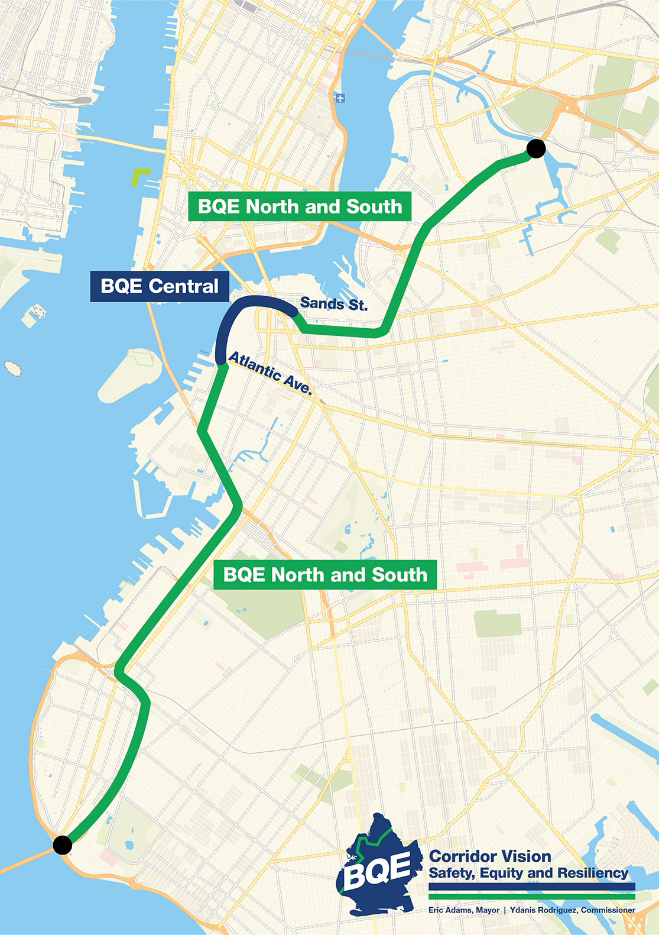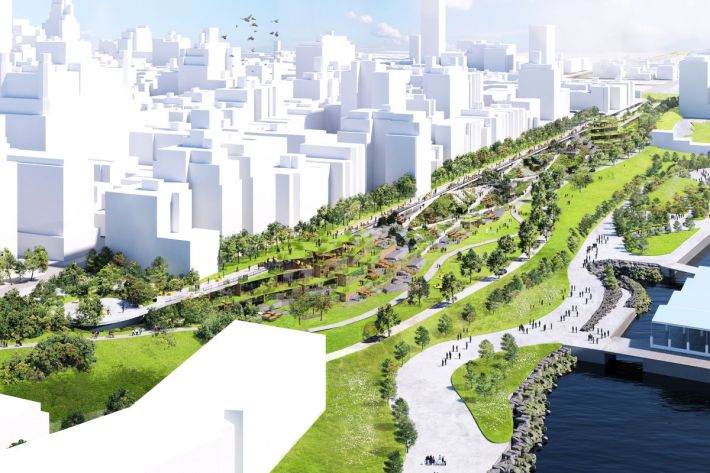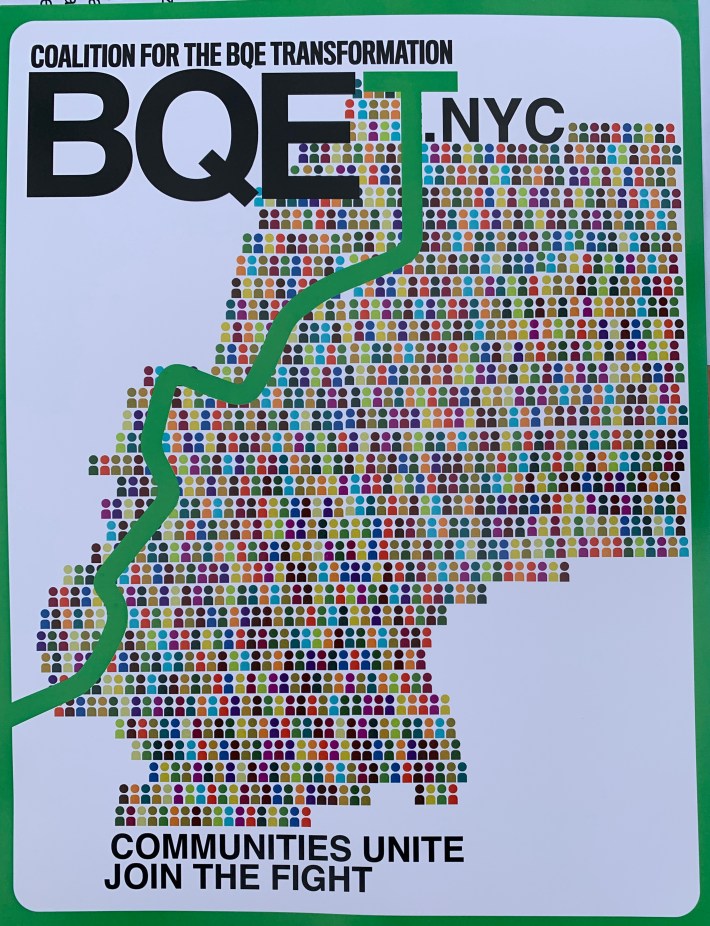It's a tale of two BQEs.
The Adams administration has firmly decided that the crumbling portion of the Brooklyn-Queens Expressway under Brooklyn Heights will be rebuilt while the open scar portions of the highway north and south of that troubled stretch will be remade with the goal of "reconnecting communities needlessly divided by the creation of the highway."

Of course, this won't be the biggest news for people who have been following along — the Adams administration is already seeking contractors [PDF] for interim repairs of parts of the triple-cantilever section of the roadway between Sands Street and Atlantic Avenue and it had also supported corridor-wide improvements — but the announcement on Friday at least puts the administration plan on a timeline with a goal.
Not a quick timeline, mind you: The full repairs on BQE Central "will start within five years," City Hall said on Friday. And the other part? No timeline was provided: "The 'BQE North and South' project engagement will identify strategies to reconnect communities north of Sands Street to the Kosciusko Bridge and south of Atlantic Avenue to the Verrazzano-Narrows Bridge that have been left out of previous BQE engagement processes," the city statement said. "With federal funds newly available through the Bipartisan Infrastructure Law, the Adams administration is taking advantage of a once-in-a-generation opportunity to fund this much-needed work on the BQE."
It's unclear what federal funds are being citied. The federal infrastructure bill did create a "Reconnecting Communities" program to provide some initial funding for planning big projects to tear down or fix urban highways that divided communities (in a largely racist way). But that program amounts to $1 billion in competitive grants across five years — or $200 million a year in a country with 50 states and hundreds of worthy projects. (City officials said there are other grant programs, too.)
Terms like "once-in-a-generation opportunity" bring to mind some of the hovering pies tossed by architects over the past few years to cover the BQE and turn it from a scar into a community resource. One such proposal, by the Bjarke Ingels Group, would put the BQE in a tunnel and cover it with a lavish park connecting Brooklyn Heights with Brooklyn Bridge Park. But that's only a tiny stretch and would cost billions.
But it's where the Adams administration dreams of getting. According to City Hall, the Department of Transportation will engage with engineering firms such as WSP USA, design firms such as WXY Architecture and Urban Design and will indeed consider the Bjarke Ingels Group proposal for "BQE Central."
Most immediately, the Adams administration will host a round of "community engagement" meetings beginning in September "to invite a wide range of voices to work towards projects that improve communities while prioritizing technical and fiscal feasibility."

It's unclear what the mayor's personal vision is beyond his signature slogan.
“It’s time to take a new approach to the BQE and ‘Get Stuff Done,’” Adams said in a statement. “Our administration [seeks] to partner with communities and develop a bold vision for a safe and resilient BQE. Together, we are finally confronting the racism built into our infrastructure and putting equity front and center to modernize this vital transportation artery now.”
But for now, the mood is optimistic, given that the Adams administration is at least focusing on a problem that Mayor de Blasio punted to his successor.
"We are thrilled," said Carlo Scissura, president and CEO of the New York Building Congress, citing the "necessary" repairs to the car infrastructure. "We also look forward to an eventual corridor-wide, full re-imagination of the BQE from Staten Island to The Bronx that serves people, communities, and the entire city. In the name of sustainability and equity for those impacted by the mistakes of yesteryear, all options for a greener, fully modernized, community-focused roadway must be considered."
That's a bit removed from Scissura's comments late in the previous mayor's administration when he said he wanted to tear down the triple cantilever.
A community group, Coalition for the Transformation of the BQE (or BQET), reminded Adams and Gov. Hochul of Scissura's earlier call for bold action, and interpreted Adams's Friday announcement as a commitment "to a permanent solution and a robust community engagement process to heal the wounds of this 1950s-era highway."
The group, which admires the Bjarke Ingels Group plan, said it seeks "an 'invisible highway' that reconnects our divided communities, combats climate change, and greatly improves public health."
It is unclear how a highway carrying 150,000 cars and 14,000 trucks every day can be made environmentally sound merely by covering it over. Former Comptroller Scott Stringer once lofted a plan to turn the BQE triple cantilever into a truck-only route, which would reduce many car trips.
The administration is seeking your help by creating a "BQE Community Visioning Council" to advise on "engagement content and strategies, meeting on a regular basis throughout the visioning process to discuss emerging concerns, plan for future engagement, analyze information from previous engagement, and share feedback."
To apply to be a visionary, click here. Applications will be accepted until the end of the day on Sept. 29. The initial outreach schedule is:
- Sept. 28: Corridor-wide kickoff (virtual)
- Oct. 6: Corridor-wide kickoff (virtual)
- Oct. 11: BQE Central workshop (in-person)
- Oct. 13: BQE Central workshop (virtual)
- Nov. 3: BQE North and South workshop (virtual)
- Nov. 7: BQE South workshop (in-person)
- Nov. 10: BQE North workshop (in-person)







